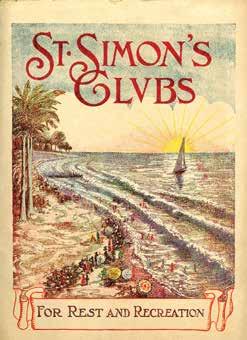
2 minute read
SSI Archives
This month’s images from the Coastal Georgia Historical Society archives are the cover of the booklet and an illustration of the clubhouse with floorplans. It appears that the East Beach familyclubhouse project was never implemented. A subdivision plat prepared for the Bruce family in 1924 shows the parcel divided into the lots that we see today.
An Early Plan to Develop East Beach
Around 1914, an intriguing promotional booklet was produced by Edward C. Bruce to interest families in buying lots on an undeveloped parcel known as East Beach. The booklet proposed an unusual type of residence for each lot: the family-clubhouse. Twenty families would band together to form a club, and each club would build a clubhouse with twenty-two small bedrooms, a “general assembly room,’’ a large screened porch, a kitchen and dining room, a servants’ room, and two bathrooms on each floor. The extra two bedrooms could be used for guests of the club members. Owners of an East Beach clubhouse would have access to 7,000 feet of frontage on the Atlantic Ocean and a beach 400 feet wide, which was “as smooth as an asphalt drive … in constant use as the main speedway for motorists during the hours when bathers are not in the surf.”
An illustration of the clubhouse design indicated that Leila Ross Wilburn of Atlanta was the architect. A native of Macon who attended Agnes Scott Institute (later Agnes Scott College), Wilburn received private instruction in architectural drawing and served as an apprentice before opening her own office. She was a pioneer in her field, not only because of her gender but also because of her business model. Instead of pursuing private commissions, she published illustrated plan books with mail-order house designs, which contractors and builders used to construct hundreds of homes throughout Georgia. Known as one of Georgia’s most prolific architects, she also designed apartment buildings and duplexes.

Our monthly images on this page are from the vast archives of the Coastal Georgia Historical Society. The Society’s mission includes the “administration, restoration and maintenance of historic facilities and resources … preserved as a living part of the historical and cultural foundations of our coastal community.” Society facilities include the St. Simons Lighthouse and Museum, the A.W. Jones Heritage Center, and the World War II Home Front Museum at the Historic Coast Guard Station. To learn more about the Society, its diverse programs, and the benefits of Society membership, please call 912.638.4666, or visit coastalgeorgiahistory.org.









